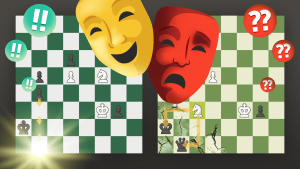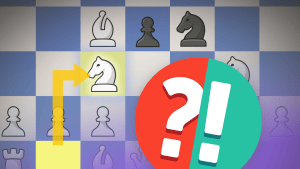
Do Arbiters Know The Rules Of Chess?
Some time ago we tried to answer the question "Do Grandmasters Know The Rules Of Chess?" and concluded that sometimes even world-class GMs forget the most basic rules of chess. But what about arbiters (called tournament directors in the U.S.)?
The people who are supposed to make sure that a chess competition goes according to the laws of chess definitely know the chess rules, right?
Unfortunately, I have witnessed so many cases of blatant arbiter mistakes (especially in scholastic competitions!), that these days besides teaching my students how to play the Ruy Lopez I also explain them the most common mistakes tournament directors make.
Let's start with the most basic situation: one of chess players overstepped the time limit. Since more and more tournaments are played with a sudden-death time control, this situation happens more frequently these days.
Here is our first game:
You can immediately spot that there is something wrong in the notation of the game. The 38. Qh8 checkmate and the result 0:1 contradict each other. What really happened is GM Alexander Ivanov was in his customary time trouble. So, while Alexander was trying to execute his winning move 38. Qh8# on the board, his flag fell. You can imagine how heartbreaking it should've been for GM Ivanov. It is a real checkmate on the board and yet he lost the game only because his flag fell a split-second before he finished his move. Therefore, the last move 38. Qh8# wasn't officially played and I included it just for your convenience, but it shouldn't be a part of the official score.

The ensuing dispute was quickly resolved and later Alexander Ivanov was awarded a prize for fair play. It is really nice when chess players know the rules well and arbiters don't get involved. Now look at the video from the Women's World Championship 2008, produced by the famous Russian chess journalist Eugene Surov:
You can start watching from 1:30. The decisive game of the match, Socko-Foisor, quickly came to the "interesting" endgame K+N vs. K+N. Eventually Black's flag fell in the following position:
I am not going to discuss if trying to flag your opponent in the K+N vs. K+N endgame in the world championship is the best way to promote chess, since here we discuss only the official rules of chess. What really shocked me there is that the game was called a draw and numerous arbiters tried to convince GM Monika Socko that this is what the laws of chess say.
But the Polish grandmaster knows the rules of chess and she correctly points out that the rules say that when the time limit is overstepped, “the game is drawn when a position is reached from which a checkmate cannot occur by any possible series of legal moves, even with the most unskilled play." -- which is obviously not the case here, since a checkmate is possible. At 2:14 she demonstrates to the arbiters such a position:
I can only express my admiration for GM Monika Socko: in a very tense and nervous situation, being greatly outnumbered by arbiters, she didn't lose her cool when she realized that all her attempts to teach the world championship arbiters the rules of chess were useless. And boy, did she try! She even managed to smile in the process! Instead, she wrote an appeal. Of course, she easily won the appeal!
I followed the above game on YouTube with special interest since I was in almost exatly same situation five years earlier. Here is the game I was playing in the U.S. championship against a master from the New York area, Aaron Pixton. In the beginning of the game I won a pawn thanks to a simple tactical trick, and was on the way to victory, or so I thought...
After my opponent played 42.Rf1, he stopped the clock and informed me that he claims the threefold repetition of the position (on moves 38, 40 and 42). Since I was in time trouble, I missed the simple fact that indeed we reached the same position three times even though the moves that led to this position were different.
Fortunately, my opponent didn't know the correct procedure for making a claim. He was supposed to write down the move 42. Rf1 on his scoresheet (not make it on the board!), and then make a claim. By actually making a move on the board he invalidated his own claim! I explained it to my opponent and he was naturally upset about this little technicality.
The tournament director unexpectedly sided with him. Luckily, the official FIDE handbook was sitting on the tournament director's desk, so it took me about 30 seconds to point at the relevant rule. I will always remember the tournament director's response: "Yes, you are right, but by the spirit of the law, I find Aaron's intention correct, so I rule the game a draw."
The deputy arbiter quickly sided with the chief arbiter. For a moment I was speechless since everything looked unreal. Almost like a common situation in a nightmare when something bad is about to happen to you, you run as fast as you can, but don't move at all. I felt the same way: I am playing the official U.S. championship, pointing at the FIDE handbook and the arbiter agrees with me and yet the game is called a draw.
Fortunately, I remembered about the appeal committee! It consisted of GMs Alex Fishbein, Sergey Kudrin and IM John Donaldson. No way in the world three chess professionals could neglect one of the basic tournament rules -- the rule that I learned when I was about 10 years old! So I wrote an appeal and in about five minutes the appeal committee unanimously overturned the arbiter's decision. The game continued and I easily converted my extra pawn into a win. Here is the conclusion of the game:
It is really sad that it was much more difficult for me to enforce the basic chess rule than to actually win the game!
The lesson is clear: know the rules. Buy the rulebook, borrow it in a library, find it on the Internet -- but learn the rules!

